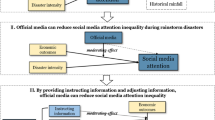Abstract
In the last one decade, social media has grown exponentially, invading geographical limitations, administrative boundaries, and even the apparent illiteracy of technology for aid. Meanwhile, this development has helped to veer off from the traditional trajectory of predominantly one-way line of communication in mainstream media, from a media-audience relationship to a media-actor/responder frame. Although there are various usages of social media before, during, and after a disaster such as early warning dissemination, preparedness guidelines, occurrence, aid requirements, and information shared in the immediate event become critical for effective response, often however resulting in a flood of information on social media, popularly referred to as “infodemic,” posing a major challenge in the decision-making process and overall management of disaster. Hence, there is a requirement of “social media policy” that places emphasis on the state-specific mandates for the usage of social media during the time of disasters for acting as a catalyst in the decision-making process and enhancing the response mechanism during the time of disasters. This chapter tries to explore the current integration of social media in disaster management plans while exploring the current trends and challenges in the usage of social media for disaster response.
Similar content being viewed by others
References
Abedin, B., & Babar, A. (2018). Institutional vs. non-institutional use of social media during emergency response: A case of twitter in 2014 Australian bush fire. Information Systems Frontiers, 20, 729–740.
Albris, K., Lauta, K. C., & Raju, E. (2020). Strengthening governance for disaster prevention: The enhancing risk management capabilities guidelines. International Journal of Disaster Risk Reduction, 47, 1–8.
Allaire, M. C. (2016). Disaster loss and social media: Can online information increase flood resilience? Water Resources Research, 52(9), 7408–7423.
Atkinson, S., Kim, D. C., & Lee, D. J. Y. (2021). Facebook as an official communication channel in a crisis. Australian Journal of Emergency Management (AJEM), 36(1), 92–98.
Babu, A. S., Babu, S., & Harikrishnan, D. (2019). Impact of social Media in Dissemination of information during a disaster – A case study of Kerala floods 2018. International Journal of Innovative Technology and Exploring Engineering (IJITEE), 8(7S2). ISSN: 2278-3075. Retrieved from: https://www.ijitee.org/wp-content/uploads/papers/v8i7s2/G10490587S219.pdf
Bathaiy, S. S., Chizari, M., Sadighi, H., & Alambeigi, A. (2021). Social media and farmer’s resilience to drought as an environmental disaster: A moderation effect. International Journal of Disaster Risk Reduction, 59, 102209.
Crowe, A. (2012). Disasters 2.0 – The application of social media systems for modern emergency management (2012 ed.). Boca Raton: CRC Press Taylor & Francis Group.
IRGC. (2017). Introduction to the IRGC risk governance framework (Revised ed.). EPFL International Risk Governance Center.
Irons, M., et al. (2014). Social media, crisis communication and community-led response and recovery: An Australian case study. Bushfire and Natural Hazards CRC.
Jeff Hemsley, J. J. (2018, July 19). Social media for social good or evil: An introduction. SAGE Journals, p. 5.
Mansyur, M. A., Homburg, V. M. F., & Koppenjan, J. F. M. (2020). The muddy practice of social media crowdsourcing in Bandung City. In Y. Murayama, D. Velev, & P. Zlateva (Eds.), Information technology in disaster risk reduction (pp. 90–101). Springer Nature.
Mauroner, O., & Heudorfer, A. (2016). Social media in disaster management: How social media impact the work of volunteer groups and aid organisations in disaster preparation and response. International Journal of Emergency Management, 12(2), 196–217.
Peary, B. D. M., Shaw, R., & Takeuchi, Y. (2012). Utilization of social media in the East Japan earthquake and Tsunami and its effectiveness. Journal of Natural Disaster Science, 34(1), 3–18.
Pitman, A. J., Narisma, G. T., & McAneney, J. (2007). The impact of climate change on the risk of forest and grassland fires in Australia. Climatic Change, 84, 383–401.
Resch, B. (2013). People as sensors and collective sensing - contextual observations complementing geo-sensor network measurements. In J. Krisp (Ed.), Advances in location-based services (pp. 391–406). Springer.
Rossi, C., et al. (2018). Early detection and information extraction for weather-induced floods using social media streams. International Journal of Disaster Risk Reduction, 30(A), 145–157.
State of Victoria (Department of Environment), L. W. a. P., 2021. Past bushfires. [Online] Available at: https://www.ffm.vic.gov.au/history-and-incidents/past-bushfires
Rekha Rani Varghese, Yadukrishnan T A. (2019) Role of social media during Kerala Floods 2018. Library Philosophy and Practice. https://digitalcommons.unl.edu/libphilprac/2754/?utm_source=digitalcommons.unl.edu%2Flibphilprac%2F2754&utm_medium=PDF&utm_campaign=PDFCoverPages
Wang, R.-Q., et al. (2018). Hyper-resolution monitoring of urban flooding with social media and crowdsourcing data. Computers and Geosciences, 111, 139–147.
Author information
Authors and Affiliations
Editor information
Editors and Affiliations
Section Editor information
Rights and permissions
Copyright information
© 2022 Springer Nature Singapore Pte Ltd.
About this entry
Cite this entry
Majumder, P., Dwivedi, D., Khera, G. (2022). Social Media as a Catalyst in Disaster Risk Governance. In: Singh, A. (eds) International Handbook of Disaster Research. Springer, Singapore. https://doi.org/10.1007/978-981-16-8800-3_91-1
Download citation
DOI: https://doi.org/10.1007/978-981-16-8800-3_91-1
Received:
Accepted:
Published:
Publisher Name: Springer, Singapore
Print ISBN: 978-981-16-8800-3
Online ISBN: 978-981-16-8800-3
eBook Packages: Springer Reference Business and ManagementReference Module Humanities and Social SciencesReference Module Business, Economics and Social Sciences




